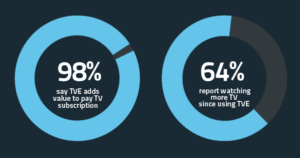Content providers made their annual pilgrimage to the 2015 Consumer Electronics Show in Las Vegas, and several were on tap at a discussion entitled, “Where Is TV Everywhere Taking Us”. With panelists from DISH Network, Disney/ABC, Comcast and TBS, attendees got an update on where the initiative is – and frustrations that it still has obstacles to overcome.

For the most part, many of the original content disagreement points – especially the once-gray area of streaming – have been worked out, enabling broader access to content. Content-industry spokespersons, however, may be reluctant to point the finger at remaining contract-related issues, fearing potential damage to delicate agreements; panelists at CEA referred to remaining problems in terms of “authentication” and “navigation,” two user-interface areas that have been solved years ago, albeit usually in vertically-integrated content distribution services. (The real trick here is, how do you provide universal access to all content, if you don’t own all the content, and you don’t service all the consumers? Usually, it means you end up charging viewers for a “package” of content that includes content they don’t care about.)
Panelists – and the industry – agree that, with the above issues resolved, the remaining one continues to be thorny: ad revenue. While mechanisms to target ads geographically and even viewer-profile-correlated are in use today, advertisers still do not have a good metric for ad consumption across all devices, and are typically stuck in the old people-meter and similar ratings systems to measure ad reach and effectiveness. But this situation is finally changing, as content distributors put a larger proportion of their content over-the-top, where the old ad measurement system is no longer relevant.
The future of “TV Everywhere” thus rests on the growth of consumer interest to view professionally-produced content on a variety of display devices. As the big TV in the living room continues to be a primary outlet for that content, we should expect to find more ways to light it up, from more internet-provided channels, from both established and entrepreneurial ventures. – Aldo Cugnini

